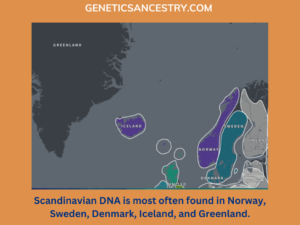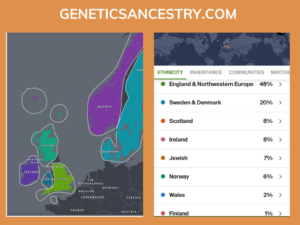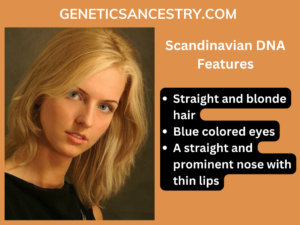Introduction
In the tapestry of human lineage, few regions evoke a sense of mystique and allure quite like Scandinavia. Nestled in the northern realms of Europe, the lands of the Vikings, fjords, and ancient legends harbor a rich and intricate ancestry waiting to be unraveled. From the towering mountains of Norway to the lush forests of Sweden and the rugged coasts of Denmark, the Scandinavian peninsula beckons with stories of resilience, exploration, and cultural depth.
Join us on a journey through time and lineage as we delve into the intricate tapestry of Scandinavian ancestry. From the enigmatic runes of the Norse sagas to the modern-day exploration of genetic heritage, we will uncover the layers of history, migration, and interconnection that have shaped the vibrant mosaic of Scandinavian identity. Whether you are tracing your own roots or simply captivated by the allure of Nordic heritage, prepare to embark on an odyssey through the annals of time, where each chapter reveals a new facet of the enduring legacy of the North.
Scandinavia comprises Denmark, Norway, Sweden, Iceland, and Greenland, sharing a deep-rooted heritage influenced by the Vikings.
This article defines the significance of Scandinavian DNA ethnicity, culture, emergence and spread to different countries, its distinctions, and how it can be a part of one’s Scandinavian DNA ancestry and DNA. Read the blog till the end to know all.
1. What is Scandinavian DNA?
- Scandinavian DNA originates from Denmark, Norway, Sweden, Iceland, and Greenland, regions historically associated with Viking expansion.
- Genetic markers spread through conquests, migrations, and intermarriages, leaving a lasting imprint on populations worldwide. Is my Scandinavian DNA from Vikings? Read till the end to know more.
2. Inclusion of Countries in the Scandinavian DNA Region
- The countries traditionally recognized as part of the Scandinavian DNA region are Denmark, Norway, and Sweden. These countries are located on the Scandinavian Peninsula, lending its name to the region. Additionally, Iceland, as well as other regions where North Germanic languages are spoken, are often grouped with Scandinavia due to linguistic similarities. This distinction is particularly pertinent when discussing Scandinavian DNA ethnicity.
- However, it’s essential to note that Finland, located to the east of the Scandinavian Peninsula, is typically not considered part of Scandinavia DNA ethnicity, despite its proximity.
3. How Scandinavian DNA Differs from Other European DNA
- Scandinavians are among Europe’s earliest settlers, with a Scandinavia DNA ethnicity distinct from later migratory groups.
- What is the Ancestry of Scandinavian people? Unlike regions influenced by Roman conquests, Scandinavia remained relatively isolated, preserving its genetic homogeneity over centuries.
4. Significance of Scandinavian DNA
- Viking migrations, driven by environmental changes and economic motives, resulted in widespread settlement and genetic intermingling.
- The Danelaw in England exemplifies Viking influence, contributing to the genetic diversity of populations, including those in the United States.
5. History of Scandinavians
Does Scandinavian DNA mean Viking? Know the history briefly to get an idea about this.
-
Post-Ice Age Settlements:
- Around 12,500 years ago, the last ice age ended, revealing the Scandinavian Peninsula.
- Early settlers, mainly hunter-gatherers, explored the newly exposed land between 9,000 and 1800 BC.
- Southern settlers developed farming and boat building skills.
-
Rise of the Vikings:
- Advances in weapons and shipbuilding during the Scandinavian Iron Age (500 BC – 800 AD) led to the Viking age (793 – 1066 AD).
- Vikings from Sweden became merchant explorers in Eastern Europe, establishing strongholds in regions like Ukraine and Russia.
- Danish Vikings raided and settled in England, leading to the establishment of Danelaw settlements.
-
Norwegian History:
- Early Norwegians, descended from similar settlers as Denmark and Sweden, mainly hunted and fished for survival.
- The Sami, nomadic reindeer herders, settled in Norway around 2500 BC.
- Norwegian Vikings interacted with Gauls and the Roman Empire and eventually settled in northern and eastern England, establishing Danelaw.
-
Finnish History:
- Finland, settled similarly to its neighboring countries, did not develop a Viking culture but interacted with Vikings.
- Christianity had minimal impact until the 11th century, and farming developed later than in other Scandinavian countries.
- Northern Finland had a nomadic lifestyle, distinct from the Sami.
-
Scandinavian Islands:
- Iceland was first settled by Vikings from Norway around 874 AD, with settlers also coming from other Scandinavian countries and England.
- Greenland had a prehistoric culture before Norwegian settlers arrived around 980 AD, possibly interacting with indigenous Inuit populations.
-
Greenland
- Greenland, the largest island in the world, possesses a rich prehistoric culture predating Norwegian settlements, distinguishing it from Iceland.
- Early Inuit migrations from islands north of the North American mainland populate Greenland, with phases of habitation occurring between 2500 BC to 700 AD, interspersed with uninhabited periods.
- Around 700 AD, the most recent wave of Inuit settlers arrived on Greenland, establishing settlements predominantly in the North, where they resided until approximately 1300 AD.
-
Later Swedish Expansion:
- Between 1500 – 1700 AD, Sweden expanded its borders to northern Germany and Baltic countries, leading to Swedish settlement in these areas.
-
Recent Spread of Scandinavian DNA:
- In the 1600s – 1700s, thousands of Norwegians migrated to the Netherlands for work and religious freedom, impacting the local population.
6. Understanding Genetic Percentages
DNA test results provide insights into ancestral origins, typically represented as percentages of Scandinavia DNA ethnicity. Genetic inheritance following a pattern, but individual variations and shared ancestry among relatives can affect specific percentages. There are many DNA testing companies such as Ancestry, 23andMe , My Heritage, etc that provide detailed analysis of genetic percentages breakdown to users.
These percentages represent the proportion of DNA inherited from different ancestral lines and geographic regions. How many generations back is 3% ethnicity? DNA inheritance follows predictable patterns, with approximately 50% inherited from each parent. Each successive generation receives approximately half the DNA of the previous generation, resulting in decreasing percentages with each ancestral layer.
7. How Much DNA Indicates a Recent Scandinavian Ancestor?
Knowing you have Scandinavian DNA Ethnicity doesn’t mean very much to you unless you can potentially pinpoint an ancestor from which it comes. When percentages are low it can often mean the connection to that region is distant and may not be traceable.
If you have a result of 40 percent Scandinavian DNA or higher indicating one of the Scandinavian regions it is likely that you have an ancestor from that region within a few generations of you. This could potentially be proven using genealogical research.
When you show a low percentage of DNA from a Scandinavian region or several regions this can be from multiple more distant ancestors. As the AncestryDNA database improves you may be able to get more refined results which might pinpoint your connection to the region more clearly.
8. Impact on Scandinavian DNA
- Scandinavia DNA ethnicity percentages can be influenced by ancestral contributions from multiple family lines.
- It’s essential to interpret percentages cautiously, as a collective amount may not accurately reflect direct ancestry from a specific region.
- Higher percentages of Scandinavian DNA results suggest more recent ancestral connections to the region.
- Combining DNA results with historical records and family trees can help pinpoint the origins of Scandinavian ancestry.
Read More At:
- Atlantic Mediterranean Neolithic Ethnicity DNA
- How To Use GEDmatch To Find Ethnicity?
- Discovering Brazilian DNA Ancestry and Ethnicity Insights
- The Genealogy of Australian Ancestry DNA
- How to Get a DNA Test While Pregnant
9. Importance of Knowing Scandinavian DNA
- What does it mean if you have Scandinavian DNA? The ability to trace Scandinavian ancestry depends on the timeframe and available documentation.
- While tracing Viking ancestry from ancient times may be challenging, more recent connections from the 1600s or 1700s may be documented in historical records.
- Building a comprehensive family tree is the first step in researching Scandinavian ancestry.
- Companies such as Ancestry give access to relevant records and resources to users for tracking ancestral roots and understanding Scandinavia DNA ethnicity heritage. DNA and family history are integral to personal identity and heritage, reflecting our shared human narrative.
- Exploring one’s genetic heritage, including Scandinavian ancestry, enriches understanding and appreciation of cultural diversity and historical connections.
10. Combining DNA Results with Family History
- Scandinavia DNA ethnicity analysis complements traditional genealogical research, offering a holistic understanding of one’s ancestry.
- Online archives, Scandinavian DNA test and family records help in tracking lineage and pinpointing the origins of specific genetic markers in ancestry such as Scandinavian DNA.
11. Physical traits and facial features of Scandinavian DNA traits may include
- straight and blonde hair
- blue colored eyes
- tall physical figure
- a straight and prominent nose with thin lips
- And non-prominent cheekbone
These are some common and prominent Scandinavian ethnicity traits.
11. Conclusion
The Scandinavian countries were first settled by mainland Europeans chasing the receding ice age glaciers. They settled down as farmers before developing skills as boat builders in their new peninsular homelands. Spreading throughout Europe, Scandinavian DNA is not uncommon and turns up in the tests of millions of ancestry hunters. Unveiling your Scandinavia DNA ethnicity not only elucidates personal ancestry but also contributes to a broader understanding of human history and migration patterns.
If you have a result of 40 percent Scandinavian DNA or higher indicating one of the Scandinavian regions it is likely that you have an ancestor from that region. Embrace your genetic journey to discover where you fit into the intricate tapestry of humanity.
FAQ’s:
What are the typical genetic markers associated with Scandinavian DNA?
Genetic markers associated with Scandinavian DNA include variations related to traits like light hair and eye color, and certain genetic predispositions.
How can I determine if I have Scandinavian DNA?
You can determine Scandinavian DNA through DNA tests provided by various genetic ancestry testing companies.
What percentage of Scandinavian DNA is considered significant?
There’s no fixed percentage, but individuals with Scandinavian ancestry typically have a noticeable proportion in their genetic test results.
Is Scandinavian DNA distinct from other European DNA?
Yes, Scandinavian DNA is distinct due to historical and geographical factors, though overlaps with other European DNA exist.
What are some common traits associated with Scandinavian DNA?
Common traits include light hair, light eye colors, fair skin, tall stature, and certain facial features.



